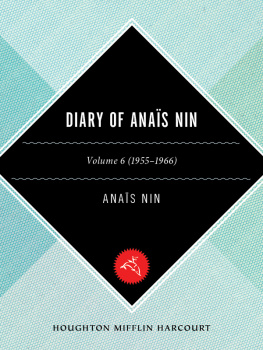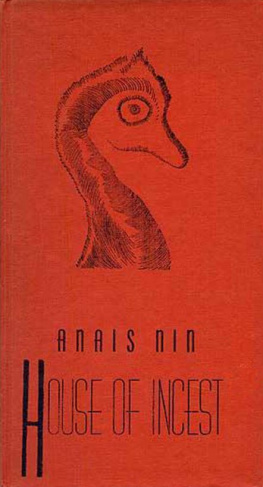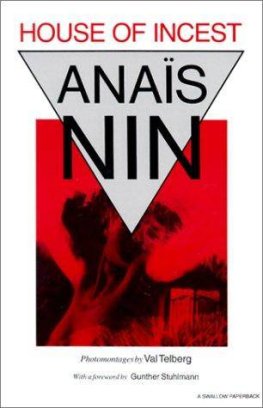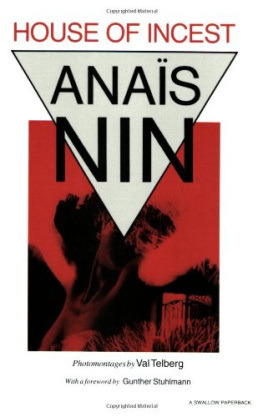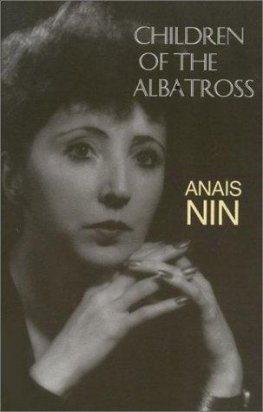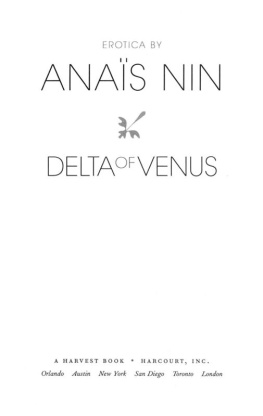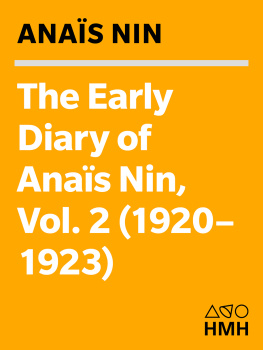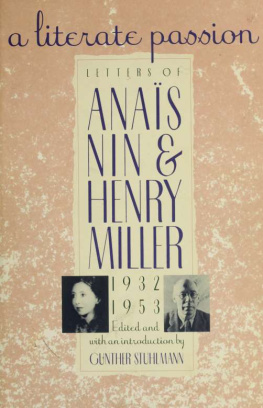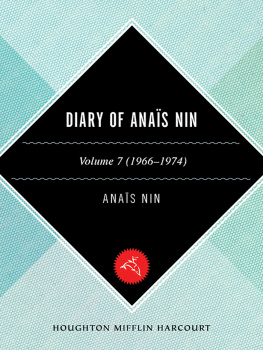Copyright 1966, 1976 by Anas Nin
Preface copyright 1976 by Gunther Stuhlmann
All rights reserved.
No part of this publication may be reproduced or transmitted in any form or by any means, electronic or mechanical including photocopy, recording, or any information storage and retrieval system, without permission in writing from the publisher.
For information about permission to reproduce selections from this book, write to Permissions, Houghton Mifflin Harcourt Publishing Company, 215 Park Avenue South, New York, New York 10003.
www.hmhbooks.com
The author wishes to thank the following for their permission to reprint the material listed: the Los Angeles Times for "Wail of Tortured Electrons Provides Eerie Film Score," by Philip K. Scheuer, copyright 1956, Los Angeles Times, and for "Journal of a Troubled Journey," by Robert Kirsch, copyright 1966, Los Angeles Times; The New York Times Company for "The Playwright's Role," by Eugene Ionesco, copyright 1958 by the New York Times Company; the San Francisco Examiner for "Paradise Lost by Mexico LSD Colony," by George Dusheck, San Francisco News-Call Bulletin, July 2, 1963.
The Library of Congress has cataloged the print edition as follows:
Nin, Anas, 19031977.
The diary of Anas Nin.
(A Harvest/HBJ book)
CONTENTS:
[6] 19551966.
Includes index.
1. Nin, Anas, 19031977Diaries.
2. Authors, American20th centuryBiography.
I. Stuhlmann, Gunther. II. Title.
PS3527.1865Z5 1977] 818'.5'203 [B] 77-3599
ISBN 0-15-626032-8
e ISBN 978-0-544-15093-5
v1.1212
This volume is dedicated to Doctors
Raymond Weston, Maclyn Wade,
Leon Morgenstern and Edward Stadler,
who saved my life in January, 1975.
And to nurses Jo Martinson and Mary Maxwell, who
gave me their own courage and energy.
Preface
During the summer of 1965, while plans for the publication of her diaries were taking definite shape, Anas Nin had a dream which, in symbolic shorthand, seemed to project her ambivalence about finally exposing her great undertaking to the world. When, in her dream, she opened the door of her house, she was struck by a blinding flash of lightby "mortal radiation," as she recorded it. Apparently, stepping out of the lifelong shelter of the Diary, her true home, posed many potential dangers.
Since their inception, Anas Nin's journals had flourished in a climate of secrecy. Protection from prying eyes, from outside judgment, had been a precondition of their growth, their continued existence. Once the original cri de coeur of the child, conceived as an open letter to the lost father, had become the opium pipe of a young woman's reflections, the warm comfort of confidentiality alone had insured the uncensored spontaneity which provided the impetus, the basic strength, for this ongoing dialogue with a nascent self. Since the 1920s, when Anas Nin, in the wake of her early marriage, had begun to secrete the growing pile of slim, handwritten volumes, they had remained in hiding for most of their existence.
Occasionally, in a grand gesture of affectionand at times perhaps to evoke an echo from her solitary enterpriseAnas Nin had shown portions of her diaries to a few trusted friends. In France, in the 1930s, she had offered up sections to June and Henry Miller, to psychoanalyst Dr. Otto Rank, to the young Lawrence Durrell. In New York, in the 1940s, she had shared such confidences with some of the "children of the albatross." Undoubtedly, such exposure had contributed, by word of mouth, sometimes in print, to the growing reputation and the quasi-legendary status of her diaries. Enthusiastic friends, economic pressures, anger and frustration at being ignored as a writer, at times had propelled Anas Nin into considering publication of her diaries. Indeed, with some reluctance she had prepared edited versions for potential publishers. But all such partial revelation, such breaking of the seals, had been momentary, confidential, always based on trust and friendship.
Anas Nin, in her own phrase, had regarded the Diary mostly as "a work of love." As such, her journals had always been handled with the protective care accorded to love itself. This was only natural as long as the Diary served as a confidante, a trusted friend, as an island retreat in a hostile, hurtful, indifferent world. But even as its functions changed, enlarged, as it grew into a more consciously applied tool, the laboratory, the instrument, of her own creation, as it became a magic wand against forgetfulness, against the passage of time, the Diary had been nourished as a private document. To expose such a work to the public, to casual scrutiny, obviously was fraught with mortal danger, as her dream so strongly implied, both for the Diary itself and for its author.
The sudden flash of exposure could easily burn forever the delicate fabric of her relationships with all those who had been captured in the labyrinth of these diaries. It could blister those nearest her, whose lives had been so closely intertwined with hers but whose "portraits" she felt did not properly belong to her alone. It could hurt those who, in moments of personal intimacy, in the confessional of psychoanalytical consultation, had entrusted her with their confidences.
Moreover, exposing the unguarded thoughts, reactions, evaluations, that she had committed to paper without the intent of ultimate disclosure, without the safeguard of artistic rearrangement, would reveal the uncertain woman, unveil the person behind the public persona, lay her open to "the maliciousness of the world." Perhaps most ominously, opening up the Diary might easily jeopardize this final refuge of her self-esteem, the stronghold of her reputation as a writer, as an artist. Exposed to the cold light of the same critics who in the past had ignored, misunderstood, or casually dismissed her deliberate creations, her sometimes self-published novels and stories, would the much-whispered-about diaries, the submerged body of what Anas Nin had so industriously, so carefully accreted over a lifetime, crumble into the dust of neglect and hostility?
Although her personal faith in the value of the diaries was unshakable, alerted by her dream, Anas Nin grew anxious and fearful. In New York, she consulted her analyst, Dr. Inge Bogner. Perhaps it would be best never to reveal the diaries. Throughout the years she had been urged, advised, to give up what she herself had sometimes regarded as her "neurotic" and "narcissistic" preoccupation. The fate of the diariestheir existence, their continuationmore than once had hung in a precarious balance. Suffering from "guilt and concern" about their content, about the effect they might have on others, she had resolved, once more, in 1955 to burn the diaries. Yet, as so often in the past, she had neither burned the diaries nor stopped keeping them.
Ten years later, Anas Nin was still hesitant, apprehensive about the consequences of revelation: "How do you tell the truth without injuring the lives of others? How do you define injury when this damage varies with each person portrayed, with each situation, with each period of time?" But she has come to an inexorable conclusion: "I have to venture, not with a work of art, separate from myself, but with myself, my body, my voice, my thoughts, all exposed."
While the blinding flash of her dream spelled danger, obviously it also symbolized release of an enormous reservoir of pent-up energy, a powerfully liberating explosion. For the slim notebooks of Anas Nin's youth had become, by 1965, a massive accumulation. Assembled over half a century, shifted from Louveciennes to Greenwich Village, to storage bins in San Francisco, in Los Angeles, almost lost in Europe in the turmoil of World War II, they now filled two five-drawer file cabinets in a Brooklyn bank vault. The sheer bulk of material, with its burdensome secrecy, the emotional weight of its content, the overwhelming significance of the diaries in shaping and creating her own life, undoubtedly had begun to exert increasing pressures on Anas Nin.
Next page
